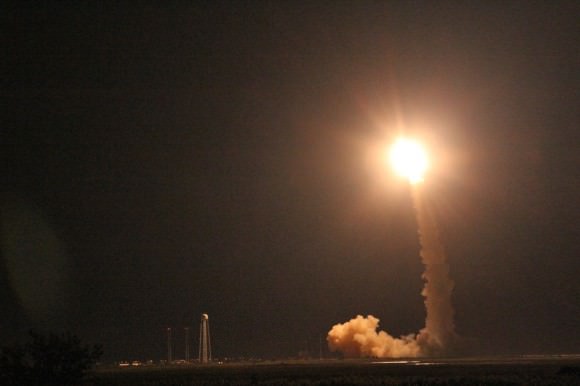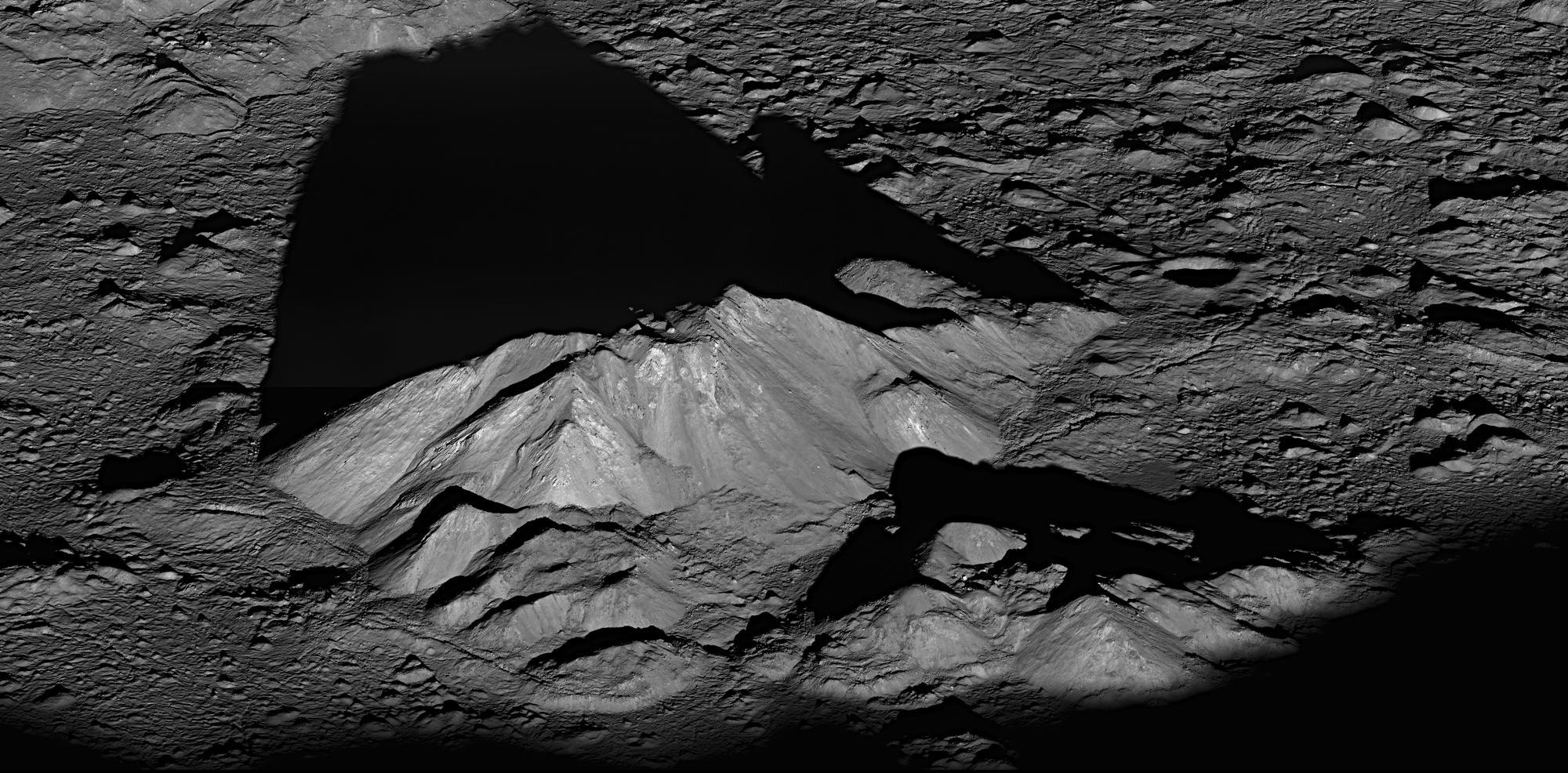Eleven years into its mission, the Lunar Reconnaissance Orbiter (LRO) is starting to show its age, but a recent software update promises to give the spacecraft a new lease on life. As NASA’s eye in the sky over the Moon, the LRO has been responsible for some of the best Lunar observations since the days of Apollo. This new upgrade will allow that legacy to continue.
Continue reading “Lunar Spacecraft Gets an Upgrade to Capture New Perspectives of the Moon”James Webb Space Telescope’s Pathfinder Mirror Backplane Arrives at NASA Goddard for Critical Assembly Testing
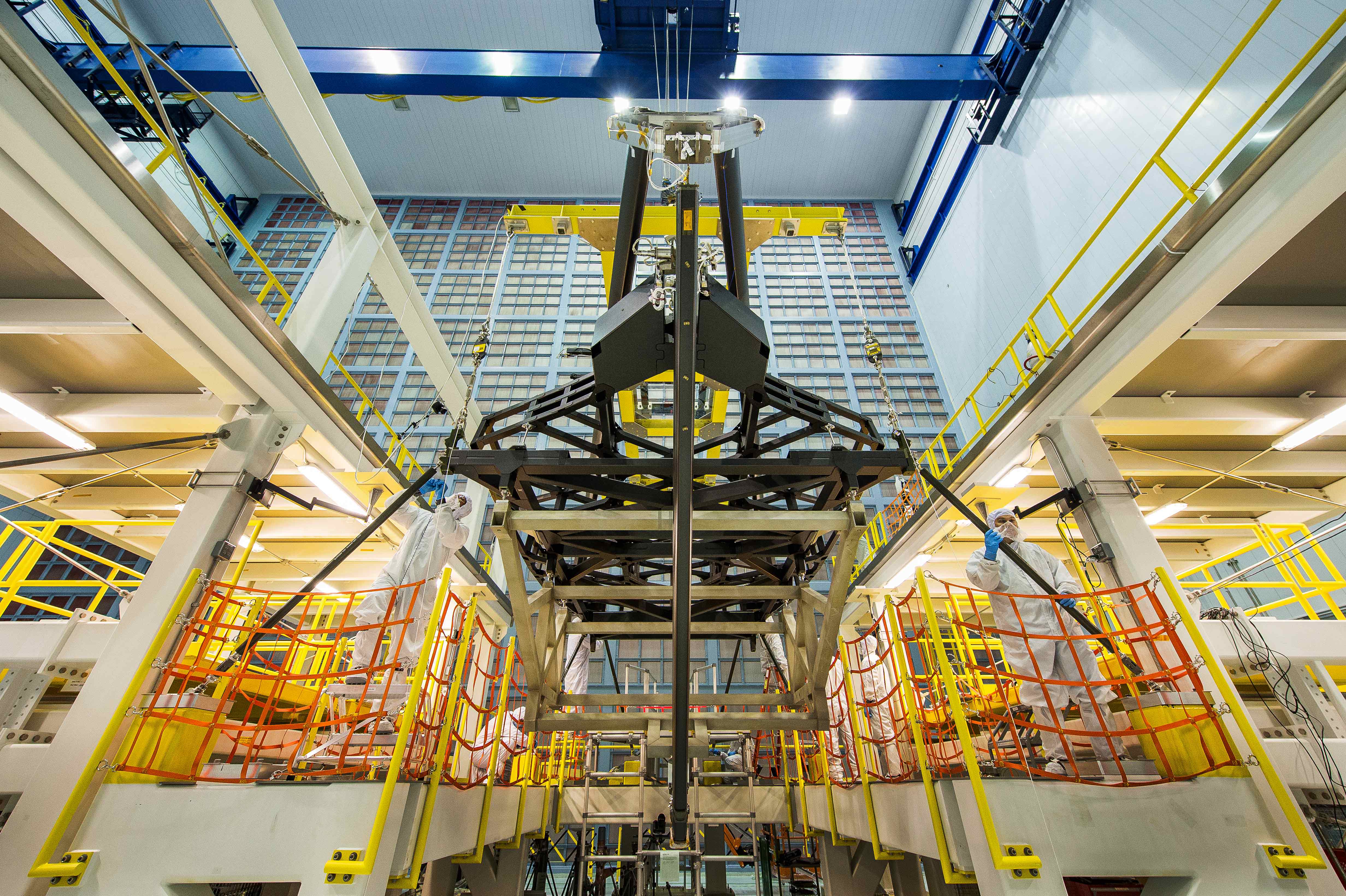
The central piece of the “pathfinder” backplane that will hold all the mirrors for NASA’s James Webb Space Telescope (JWST) has arrived at the agency’s Goddard Space Flight Center in Maryland for critical assembly testing on vital parts of the mammoth telescope.
The pathfinder backplane arrived at Goddard in July and has now been hoisted in place onto a huge assembly stand inside Goddard’s giant cleanroom where many key elements of JWST are being assembled and tested ahead of the launch scheduled for October 2018.
The absolutely essential task of JWST’s backplane is to hold the telescopes 18 segment, 21-foot-diameter primary mirror nearly motionless while floating in the utterly frigid space environment, thereby enabling the telescope to peer out into deep space for precise science gathering measurements never before possible.
Over the next several months, engineers will practice installing two spare primary mirror segments and one spare secondary mirror onto the center part of the backplane.
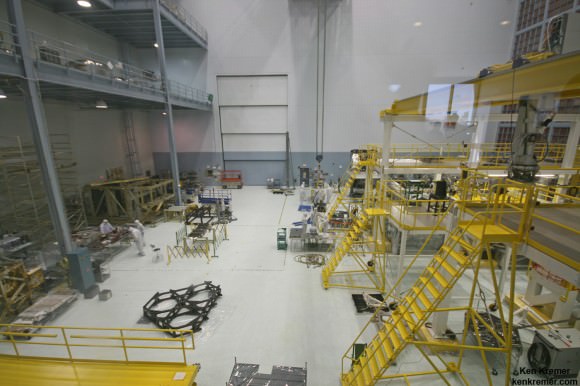
JWST is being assembled here inside the world’s largest clean room at NASA Goddard Space Flight Center, Greenbelt, Md. Primary mirror segments stored in silver colored containers at top left. Technicians practice mirror installation on test piece of backplane (known as the BSTA or Backplane Stability Test Article) at center, 3 hexagonals. Pathfinder backplane has been hoisted into telescope assembly bays at right. Credit: Ken Kremer- kenkremer.com
The purpose is to gain invaluable experience practicing the delicate procedures required to precisely install the hexagonal shaped mirrors onto the actual flight backplane unit after it arrives.
The telescopes primary and secondary flight mirrors have already arrived at Goddard.
The mirrors must remained precisely aligned in space in order for JWST to successfully carry out science investigations. While operating at extraordinarily cold temperatures between -406 and -343 degrees Fahrenheit the backplane must not move more than 38 nanometers, approximately 1/1,000 the diameter of a human hair.
The backplane and every other component must function and unfold perfectly and to precise tolerances in space because JWST has not been designed for servicing or repairs by astronaut crews voyaging beyond low-Earth orbit into deep space, William Ochs, Associate Director for JWST at NASA Goddard told me in an interview during a visit to JWST at Goddard.
Watch this video showing movement of the pathfinder backplane into the Goddard cleanroom.
Video Caption: This is a time-lapse video of the center section of the ‘pathfinder’ backplane for NASA’s James Webb Space Telescope being moved into the clean room at NASA’s Goddard Space Flight Center in Greenbelt, Maryland. Credit: NASA/Chris Gunn
The actual flight backplane is comprised of three segments – the main central segment and a pair of outer wing-like parts which will be folded over into launch configuration inside the payload fairing of the Ariane V ECA booster rocket. The telescope will launch from the Guiana Space Center in Kourou, French Guiana in 2018.
Both the backplane flight unit and the pathfinder unit, which consists only of the center part, are being assembled and tested by prime contractor Northrop Grumman in Redondo Beach, California.
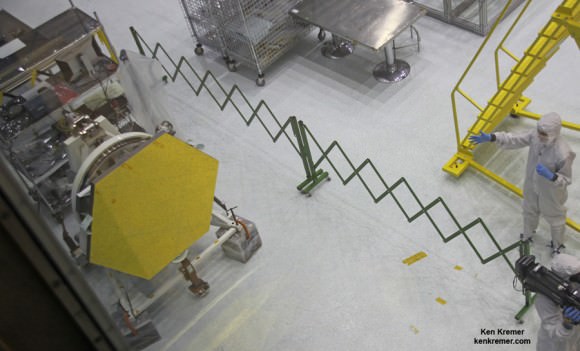
The test unit was then loaded into a C-5, flown to the U.S. Air Force’s Joint Base Andrews in Maryland and unloaded for transport by trailer truck to NASA Goddard in Greenbelt, Maryland.
JWST is the successor to the 24 year old Hubble Space Telescope and will become the most powerful telescope ever sent to space.
Webb is designed to look at the first light of the Universe and will be able to peer back in time to when the first stars and first galaxies were forming.
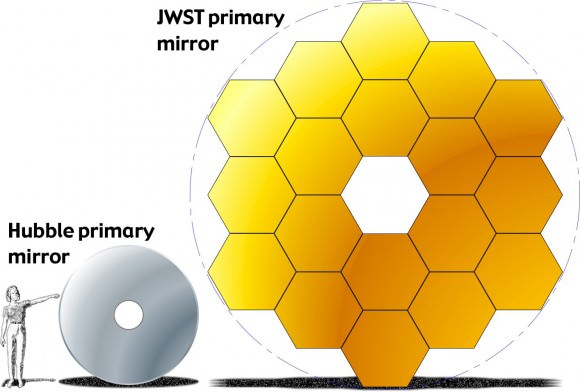
The Webb Telescope is a joint international collaborative project between NASA, the European Space Agency (ESA) and the Canadian Space Agency (CSA).
NASA has overall responsibility and Northrop Grumman is the prime contractor for JWST.
Read my story about the recent unfurling test of JWST’s sunshade – here.
Stay tuned here for Ken’s continuing Earth and Planetary science and human spaceflight news.
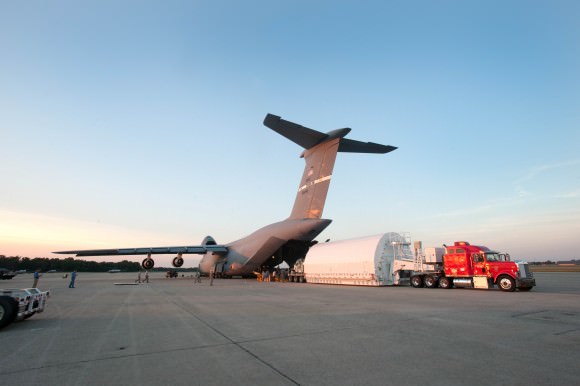
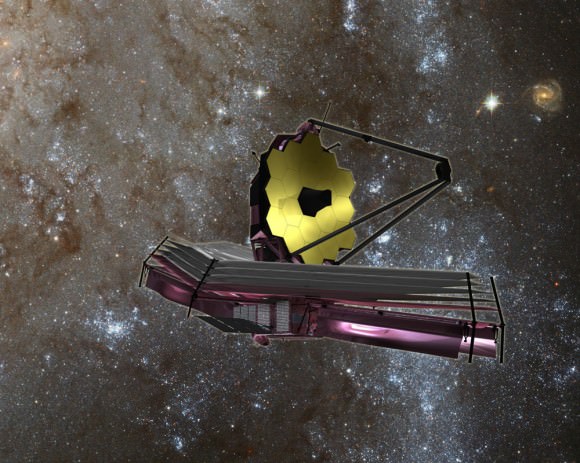
James Webb Space Telescope’s Giant Sunshield Test Unit Unfurled First Time
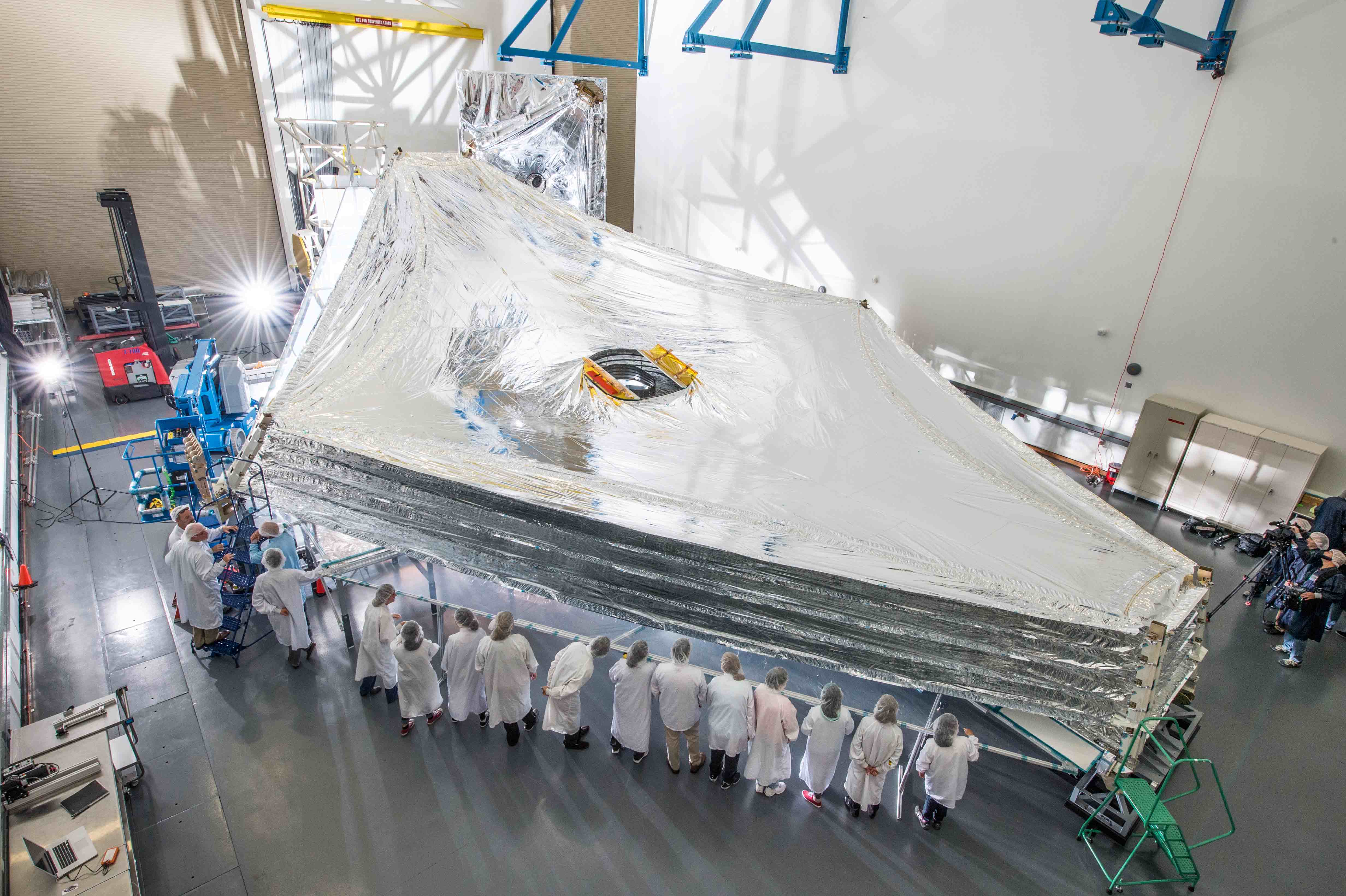
GODDARD SPACE FLIGHT CENTER, MD – The huge Sunshield test unit for NASA’s James Webb Space Telescope (JWST) has been successfully unfurled for the first time in a key milestone ahead of the launch scheduled for October 2018.
Engineers stacked and expanded the tennis-court sized Sunshield test unit last week inside the cleanroom at a Northrop Grumman facility in Redondo Beach, California.
NASA reports that the operation proceeded perfectly the first time during the test of the full-sized unit.
The Sunshield and every other JWST component must unfold perfectly and to precise tolerances in space because it has not been designed for servicing or repairs by astronaut crews voyaging beyond low-Earth orbit into deep space, William Ochs, Associate Director for JWST at NASA Goddard told me in an exclusive interview.

The five layered Sunshield is the largest component of the observatory and acts like a parasol.
Its purpose is to protect Webb from the suns heat and passively cool the telescope and its quartet of sensitive science instruments via permanent shade to approximately 45 kelvins, -380 degrees F, -233 C.
The kite-shaped Sunshield provides an effective sun protection factor or SPF of 1,000,000. By comparison suntan lotion for humans has an SPF of 8 to 40.

The extreme cold is required for the telescope to function in the infrared (IR) wavelengths and enable it to look back in time further than ever before to detect distant objects.
The shield separates the observatory into a warm sun-facing side and a cold anti-sun side.
Its five thin membrane layers also provides a stable thermal environment to keep the telescopes 18 primary mirror segments properly aligned for Webb’s science investigations.
JWST is the successor to the 24 year old Hubble Space Telescope and will become the most powerful telescope ever sent to space.
The Webb Telescope is a joint international collaborative project between NASA, the European Space Agency (ESA) and the Canadian Space Agency (CSA).
NASA has overall responsibility and Northrop Grumman is the prime contractor for JWST.
Webb will launch folded up inside the payload fairing of an ESA Ariane V ECA rocket from the Guiana Space Center in Kourou, French Guiana.
In launch configuration, the Sunshield will surround the main mirrors and instruments like an umbrella.
During the post launch journey to the L2 observing orbit at the second Sun-Earth Lagrange point nearly a million miles (1.5 million Km) from Earth, the telescopes mirrors and sunshield will begin a rather complex six month long unfolding and calibration process.
The science instruments have been mounted inside the ISIM science module and are currently undergoing critical vacuum chamber testing at NASA Goddard Space Flight Center which provides overall management and systems engineering.

The mirror segments have arrived at NASA Goddard where I’ve had the opportunity to observe and report on work in progress.
Stay tuned here for Ken’s continuing JWST, MMS, ISS, Curiosity, Opportunity, SpaceX, Orbital Sciences, Boeing, Orion, MAVEN, MOM, Mars and more Earth and Planetary science and human spaceflight news.
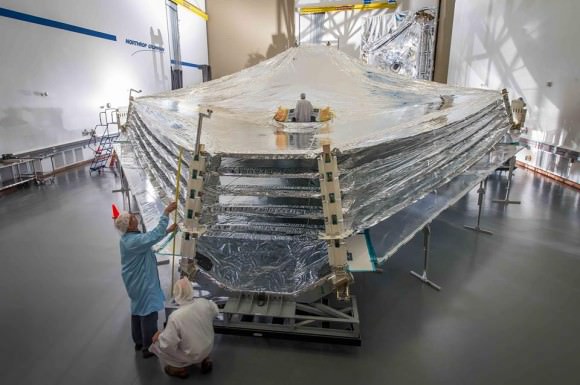
Why Commercial Crew is Critical for Future Exploration: One-on-One Interview with NASA Administrator Charles Bolden

NASA Administrator Charles Bolden discusses future of NASA human spaceflight during exploration forum at NASA Headquarters, Washington, DC. Credit: Ken Kremer- kenkremer.com
Story updated[/caption]
NASA GODDARD SPACE FLIGHT CENTER, MD – Why is NASA’s Commercial Crew Program to develop private human transport ships to low Earth orbit important?
That’s the question I posed to NASA Administrator Charles Bolden when we met for an exclusive interview at NASA Goddard.
The Commercial Crew Program (CCP) is the critical enabler “for establishing a viable orbital infrastructure” in the 2020s, NASA Administrator Charles Bolden told Universe Today in an exclusive one-on-one interview at NASA’s Goddard Space Flight Center in Greenbelt, Md.
Bolden, a Space Shuttle commander who flew four time to space, says NASA wants one of the new American-made private crewed spaceships under development by SpaceX, Boeing and Sierra Nevada – with NASA funding – to be ready to ferry US astronauts to the International Space Station (ISS) and back to Earth by late 2017. Flights for other commercial orbital space ventures would follow later and into the next decade.
Since the shutdown of NASA’s space shuttle program following the final flight by STS-135 in 2011 (commanded by Chris Ferguson), America has been 100% dependent on the Russians to fly our astronauts to the space station and back.
“Commercial crew is critical. We need to have our own capability to get our crews to space,” Bolden told me, during a visit to the NASA Goddard cleanroom with the agency’s groundbreaking Magnetospheric Multiscale (MMS) science probes.
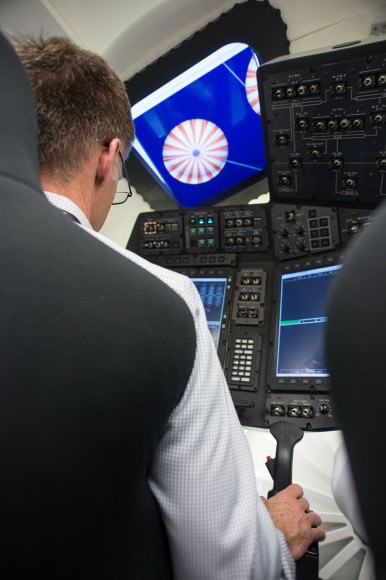
Administrator Bolden foresees a huge shift in how the US will conduct space operations in low earth orbit (LEO) just a decade from now. The future LEO architecture will be dominated not by NASA and the ISS but rather by commercial entrepreneurs and endeavors in the 2020s.
“There are going to be other commercial stations or other laboratories,” Bolden excitedly told me.
And the cash strapped Commercial Crew effort to build new astronaut transporters is the absolutely essential enabler to get that exploration task done, he says.
“Commercial Crew is critical to establishing the low Earth orbit infrastructure that is required for exploration.”
“We have got to have a way to get our crews to space.”
“You know people try to separate stuff that NASA does into nice little neat packages. But it’s not that way anymore.”
Bolden and NASA are already looking beyond the ISS in planning how to use the new commercial crew spaceships being developed by SpaceX, Boeing and Sierra Nevada in a public- partnership with NASA’s Commercial Crew Program.
“Everything we do [at NASA] is integrated. We have to have commercial crew [for] a viable low Earth orbit infrastructure – a place where we can do testing – for example with what’s going on at the ISS today.”
“And in the out years you are going to be doing the same type of work.”
“But it’s not going to be on the ISS.”
“After 2024 or maybe 2028, if we extend it again, you are going to see the people on commercial vehicles. There are going to be other stations or other laboratories.”
“But there won’t be NASA operated laboratories. They will be commercially viable and operating laboratories.”
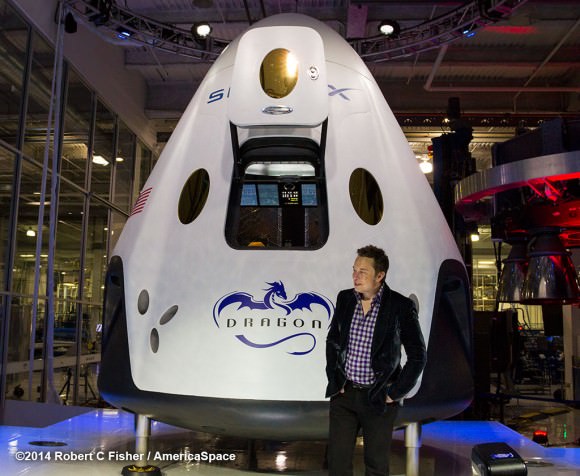
Private NewSpace ventures represent a revolutionary departure from current space exploration thinking. But none of these revolutionary commercial operations will happen if we don’t have reliable and cost effective human access to orbit from American soil with American rockets on American spaceships.
“We need to have our own capability to get our crews to space – first of all. That’s why commercial crew is really, really, really important,” Bolden emphasized.
The ongoing crises in Ukraine makes development of a new US crew transporter to end our total reliance on Russian spaceships even more urgent.
“Right now we use the Russian Soyuz. It is a very reliable way to get our crews to space. Our partnership with Roscosmos is as strong as it’s ever been.”
“So we just keep watching what’s going on in other places in the world, but we continue to work with Roscosmos the way we always have,” Bolden stated.
The latest example is this week’s successful launch of the new three man Russian-US- German Expedition 40 crew to the ISS on a Soyuz.
Of course, the speed at which the US develops the private human spaceships is totally dependent on the funding level for the Commercial Crew program.
Unfortunately, progress in getting the space taxis actually built and flying has been significantly slowed because the Obama Administration CCP funding requests for the past few years of roughly about $800 million have been cut in half by a reluctant US Congress. Thus forcing NASA to delay the first manned orbital test flights by at least 18 months from 2015 to 2017.
And every forced postponement to CCP costs US taxpayers another $70 million payment per crew seat to the Russians. As a result of the congressional CCP cuts more than 1 Billion US Dollars have been shipped to Russia instead of on building our own US crew transports – leaving American aerospace workers unemployed and American manufacturing facilities shuttered.
I asked Bolden to assess NASA’s new funding request for the coming fiscal year 2015 currently working its way through Congress.
“It’s looking better. It’s never good. But now it’s looking much better,” Bolden replied.
“If you look at the House markup that’s a very positive indication that the budget for commercial crew is going to be pretty good.”
The pace of progress in getting our crews back to orbit basically can be summed up in a nutshell.
“No Bucks, No Buck Rogers,” Chris Ferguson, who now leads Boeing’s crew effort, told me in a separate exclusive interview for Universe Today.
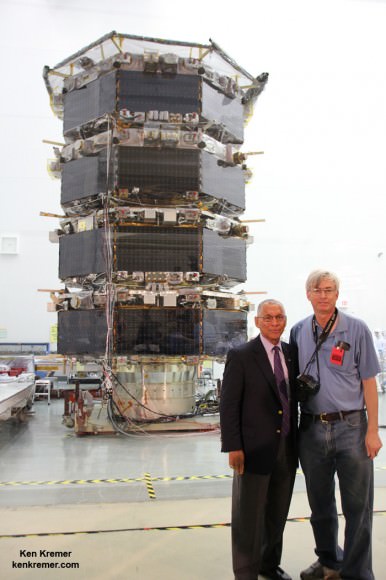
The Boeing CST-100, Sierra Nevada Dream Chaser and SpaceX Dragon ‘space taxis’ are all vying for funding in the next round of contracts to be awarded by NASA around late summer 2014 known as Commercial Crew Transportation Capability (CCtCap).
All three company’s have been making excellent progress in meeting their NASA mandated milestones in the current contract period known as Commercial Crew Integrated Capability initiative (CCiCAP) under the auspices of NASA’s Commercial Crew Program.
Altogether they have received more than $1 Billion in NASA funding under the current CCiCAP initiative. Boeing and SpaceX were awarded contracts worth $460 million and $440 million, respectively. Sierra Nevada was given what amounts to half an award worth $212.5 million.
SpaceX CEO Elon Musk just publicly unveiled his manned Dragon V2 spaceship on May 29.
Boeing’s Chris Ferguson told me that assembly of the CST-100 test article starts soon at the Kennedy Space Center.
NASA officials have told me that one or more of the three competitors will be chosen later this year in the next phase under CCtCAP to build the next generation spaceship to ferry astronauts to and from the ISS by 2017.
In order to certify the fitness and safety of the new crew transporters, the CCtCAP contracts will specify that “each awardee conduct at least one crewed flight test to verify their spacecraft can dock to the space station and all its systems perform as expected.”

Concurrently, NASA is developing the manned Orion crew vehicle for deep space exploration. The state-of-the-art capsule will carry astronauts back to the Moon and beyond on journeys to Asteroids and one day to Mars.
“We need to have our own capability to get our crews to space. Commercial Crew is critical to establishing the low Earth orbit infrastructure that is required for exploration,” that’s the bottom line message from my interview with NASA Administrator Bolden.
Stay tuned here for Ken’s continuing SpaceX, Boeing, Sierra Nevada, Orbital Sciences, commercial space, Orion, Mars rover, MAVEN, MOM and more planetary and human spaceflight news.
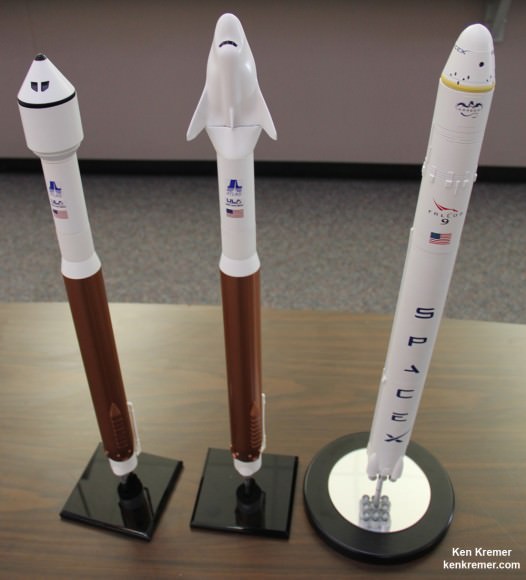
NASA’s Magnetospheric Multiscale Mission to Provide 1st 3-D View of Earth’s Magnetic Reconnection Process – Cleanroom visit with Bolden
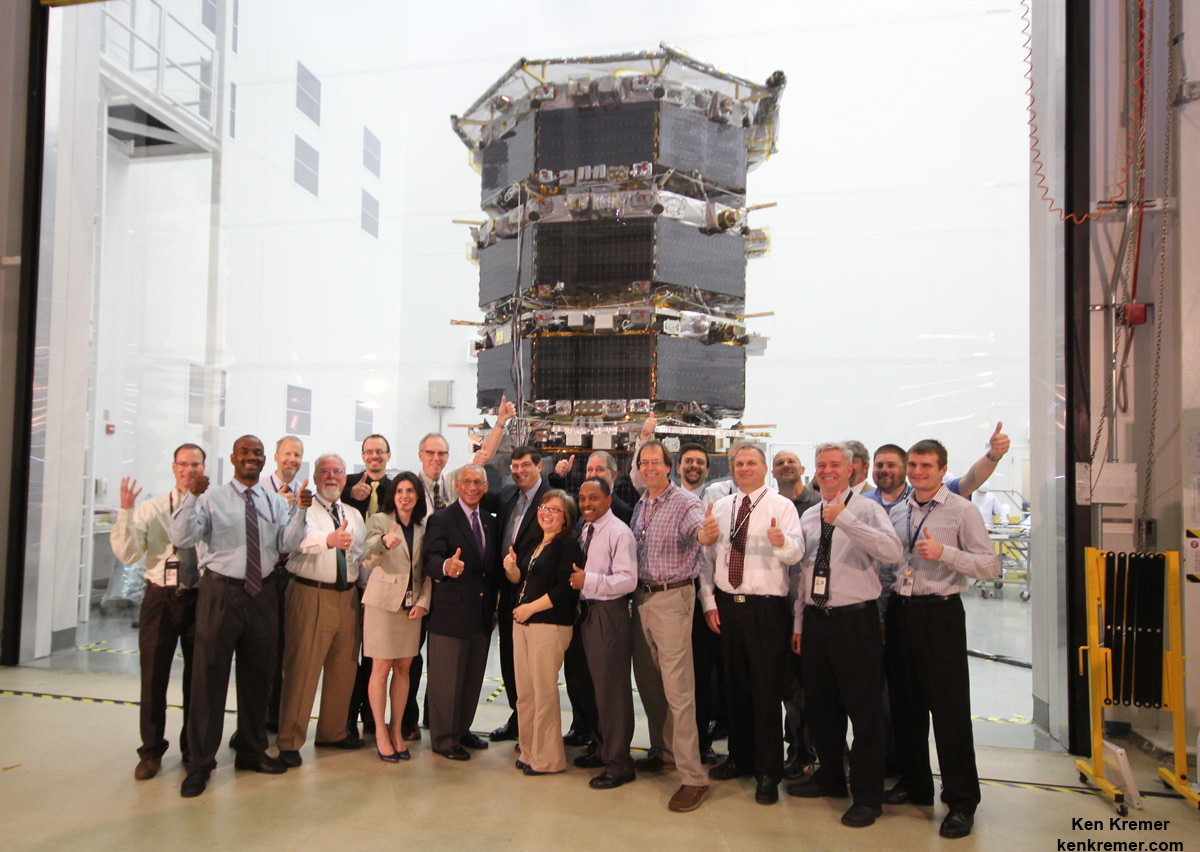
NASA Administrator Charles Bolden poses with the agency’s Magnetospheric Multiscale (MMS) spacecraft, mission personnel, Goddard Center Director Chris Scolese and NASA Associate Administrator John Grunsfeld, during visit to the cleanroom at NASA’s Goddard Space Flight Center in Greenbelt, Md., on May 12, 2014. Credit: Ken Kremer- kenkremer.com
Story updated[/caption]
NASA GODDARD SPACE FLIGHT CENTER, MD – NASA’s upcoming Magnetospheric Multiscale (MMS) mission is comprised of a quartet of identically instrumented observatories aimed at providing the first three-dimensional views of a fundamental process in nature known as magnetic reconnection. They were unveiled to greet NASA Administrator Charles Bolden on Monday, May 12, in a rare fully stacked arrangement inside the Goddard cleanroom.
Universe Today was on hand with NASA Administrator Bolden, Science Mission Chief John Grunsfeld and the MMS mission team at Goddard for a first hand inspection and up close look at the 20 foot tall, four spacecraft stacked configuration in the cleanroom and for briefings about the projects fundamental science goals.
“I’m visiting with the MMS team today to find out the status of this mission scheduled to fly early in 2015. It’s one of many projects here at Goddard,” NASA Administrator Bolden told me in an exclusive one-on-one interview at the MMS cleanroom.
“MMS will help us study the phenomena known as magnetic reconnection and help us understand how energy from the sun – magnetic and otherwise – affects our own life here on Earth. MMS will study what effects that process … and how the magnetosphere protects Earth.”
Magnetic reconnection is the process whereby magnetic fields around Earth connect and disconnect while explosively releasing vast amounts of energy.
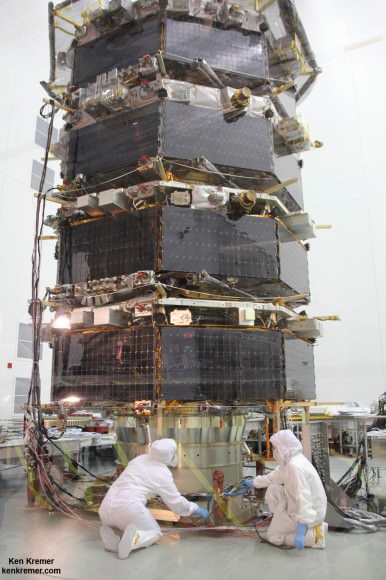
MMS measurements should lead to significant improvements in models for yielding better predictions of space weather and thereby the resulting impacts for life here on Earth as well as for humans aboard the ISS and robotic satellite explorers in orbit and the heavens beyond.
The four identical spacecraft – which are still undergoing testing – were stacked in a rarely seen launch arrangement known affectionately as the “IHOP configuration” – because they look rather like a stack of luscious pancakes.
“MMS is a fundamental heliophysics science mission,” Craig Tooley told me at the MMS cleanroom. Tooley is MMS project manager at NASA Goddard.
“Unlike Hubble that uses remote sensing, MMS is like a flying laboratory ‘in situ’ that will capture events that are the major energy transfer from the sun’s magnetic field into our Earth’s space weather environment and magnetosphere.”
“These are called magnetic reconnection events that pump enormous amounts of energy into the plasma and the fields around Earth. It’s one of the main drivers of space weather and a fundamental physical process that is not very well understood,” Tooley explained.
“The spacecraft were built in-house here at Goddard and just completed vibration testing.”
MMS will launch atop an Atlas V rocket in March 2015 from Space launch Complex 41, Cape Canaveral Air Force Station, Florida.
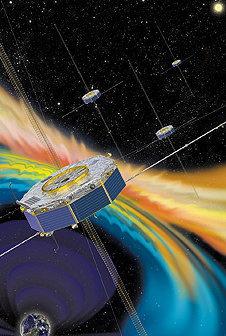
The vibration testing is a major milestone and is conducted to ensure the spacecraft can withstand the most extreme vibration and dynamic loads they will experience and which occurs during liftoff inside the fairing of the Atlas V booster.
MMS is also another highly valuable NASA science mission (along with MAVEN, LADEE and others) which suffered launch delays and increased costs as a result of the US government shutdown last October 2013, Bolden confirmed to Universe Today.
“We ended up slipping beyond the original October 2014 date due to the government shutdown and [the team] being out of work for a couple of weeks. MMS is now scheduled to launch in March 2015,” Bolden told me.
“So then you are at the mercy of the launch provider.”
“The downside to slipping that far is that’s its [MMS] costing more to launch,” Bolden stated.
Each of the Earth orbiting spacecraft is outfitted with 25 science sensors to study the microphysics of three fundamental plasma processes: magnetic reconnection, energetic particle acceleration, and turbulence.
Magnetic reconnection occurs throughout our universe.
“The primary mission will last two years,” Tooley told me.
“Each spacecraft carries about 400 kilograms of fuel. There is a possibility to extend the mission by about a year based on fuel consumption.”

The spacecraft will use the Earth itself as a laboratory to unlock the mysteries of magnetic reconnection – the primary process that transfers energy from the solar wind into Earth’s magnetosphere and is responsible for geomagnetic storms.
“To understand the fundamental physics, they will fly in a pyramid-like formation and capture the magnetic reconnection events in 3-D by flying through them as they happen – that’s why we have 4 spacecraft,” Tooley explained.
“Initially they will be spaced apart by about 10 to 30 kilometers while they fly in a tetrahedron formation and scan with their booms spread out – depending on what the scientists says is the optimal configuration.”
“They fly in a highly elliptical orbit between about 7,000 and 75,000 kilometers altitude during the first half of the mission. Eventually the orbit will be extended out to about 150,000 kilometers.”
The best place to study magnetic reconnection is ‘in situ’ in Earth’s magnetosphere.
This will lead to better predictions of space weather phenomena.
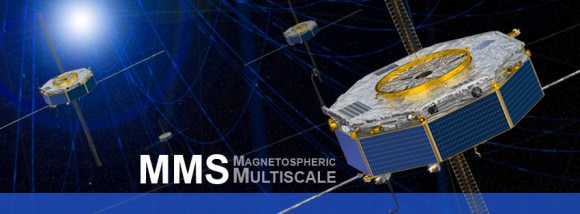
Magnetic reconnection is also believed to help trigger the spectacular aurora known as the Northern or Southern lights.
Stay tuned here for Ken’s continuing MMS, Curiosity, Opportunity, SpaceX, Orbital Sciences, Boeing, Orion, LADEE, MAVEN, MOM, Mars and more planetary and human spaceflight news.
………
Ken’s upcoming presentation: Mercy College, NY, May 19: “Curiosity and the Search for Life on Mars” and “NASA’s Future Crewed Spaceships.”
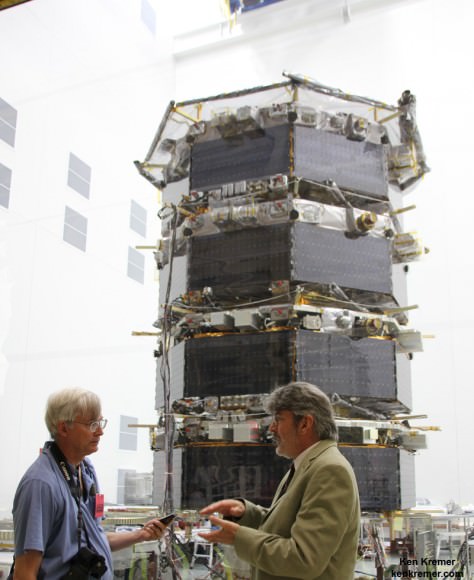
1st Images from New NASA/JAXA GPM Rainfall Measuring Satellite Capture Tropical Cyclone in 3D

KENNEDY SPACE CENTER, FL – Weather researchers worldwide now have the ability to capture unprecedented three-dimensional images and detailed rainfall measurements of cyclones, hurricanes and other storms from space on a global basis thanks to the newest Earth observing weather satellite – jointly developed by the US and Japan.
NASA and the Japan Aerospace Exploration Agency (JAXA) have now released the first images captured by their Global Precipitation Measurement (GPM) Core Observatory satellite.
GPM soared to space on Feb. 27, exactly one month ago, during a spectacular night launch from the Japanese spaceport at the Tanegashima Space Center on Tanegashima Island off southern Japan.
The newly released series of images show precipitation falling inside a vast extra-tropical cyclone cascading over a vast swath of the northwest Pacific Ocean, approximately 1,000 miles off the coast of eastern Japan.
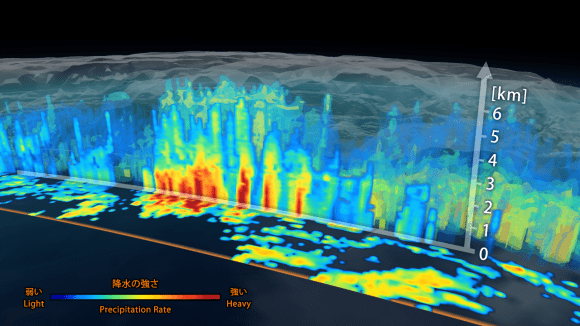
“It was really exciting to see this high-quality GPM data for the first time,” said GPM project scientist Gail Skofronick-Jackson at NASA’s Goddard Spaceflight Center in Greenbelt, Md., in a NASA statement.
“I knew we had entered a new era in measuring precipitation from space. We now can measure global precipitation of all types, from light drizzle to heavy downpours to falling snow.”
The imagery was derived from measurements gathered by GPM’s two advanced instruments: JAXA’s high resolution dual-frequency precipitation (DPR) radar instrument (Ku and Ka band), which imaged a three-dimensional cross-section of the storm, and the GPM microwave imager (GMI) built by Ball Aerospace in the US which observed precipitation across a broad swath.
“The GMI instrument has 13 channels that measure natural energy radiated by Earth’s surface and also by precipitation itself. Liquid raindrops and ice particles affect the microwave energy differently, so each channel is sensitive to a different precipitation type,” according to a NASA statement.
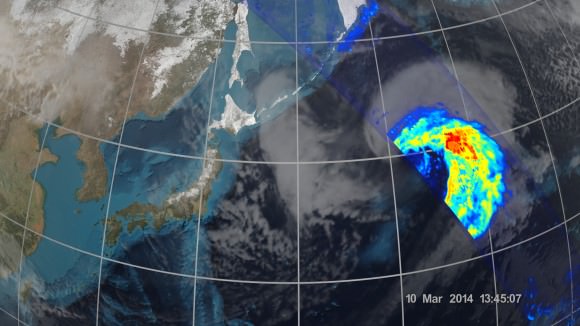
The 3850 kilogram GPM observatory is the first satellite designed to measure light rainfall and snow from space, in addition to heavy tropical rainfall.
The data were released following check out and activation of the satellites pair of instruments.
“GPM’s precipitation measurements will look like a CAT scan,” Dr. Dalia Kirschbaum, GPM research scientist, told me during a prelaunch interview with the GPM satellite in the cleanroom at NASA’s Goddard Space Flight Center in Greenbelt, Md.
“The radar can scan through clouds to create a three dimensional view of a clouds structure and evolution.”
The $933 Million GPM observatory will provide high resolution global measurements of rain and snow every 3 hours. It is a joint venture between NASA and JAXA.
It will collect a treasure trove of data enabling the most comprehensive measurements ever of global precipitation – and across a wide swath of the planet where virtually all of humanity lives from 65 N to 65 S latitudes.
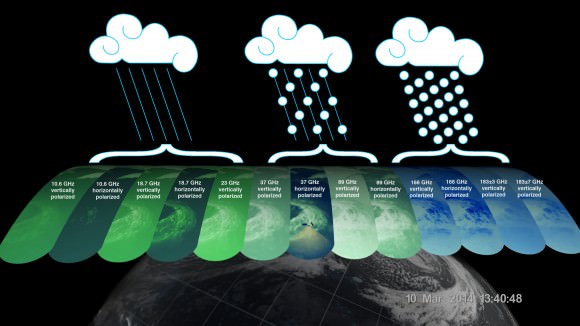
GPM orbits at an altitude of 253 miles (407 kilometers) above Earth – quite similar to the International Space Station (ISS).
GPM is the lead observatory of a constellation of nine highly advanced Earth orbiting weather research satellites contributed by the US, Japan, Europe and India.
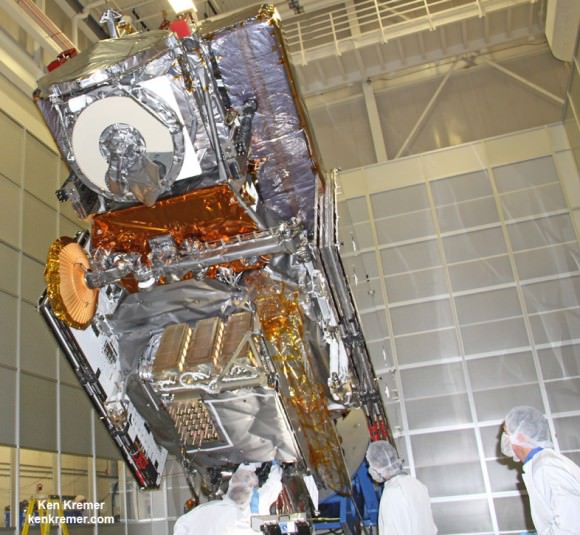
Stay tuned here for Ken’s continuing GPM, Curiosity, Opportunity, Chang’e-3, SpaceX, Orbital Sciences, LADEE, MAVEN, MOM, Mars and more planetary and human spaceflight news.
Learn more at Ken’s upcoming presentations at the NEAF convention on April 12/13 and at Washington Crossing State Park, NJ on April 6. Also at the Quality Inn Kennedy Space Center, Titusville, FL, March 29.
Next Generation NASA/JAXA Global Weather Research Satellite thunders aloft from Japanese Spaceport
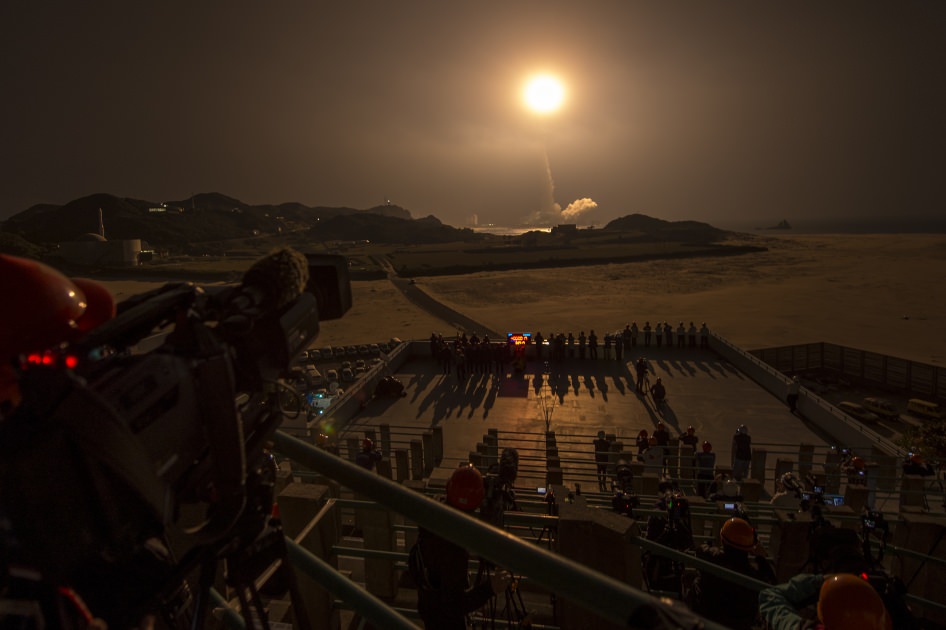
GPM Launch Seen From the Tanegashima Space Center
A Japanese H-IIA rocket with the NASA-Japan Aerospace Exploration Agency (JAXA), Global Precipitation Measurement (GPM) Core Observatory onboard, is seen launching from the Tanegashima Space Center on Friday, Feb. 28, 2014 (Japan Time), in Tanegashima, Japan; Thursday, Feb. 27, EST. Credit: NASA/Bill Ingalls[/caption]
NASA GODDARD SPACE FLIGHT CENTER, MARYLAND – A powerful, next generation weather observatory aimed at gathering unprecedented 3-D measurements of global rain and snowfall rates – and jointly developed by the US and Japan – thundered to orbit today (Feb. 27 EST, Feb. 28 JST) ) during a spectacular night time blastoff from a Japanese space port.
The Global Precipitation Measurement (GPM) Core Observatory was launched precisely on time at 1:37 p.m. EST, 1837 GMT, Thursday, Feb. 27 (3:37 a.m. JST Friday, Feb. 28) atop a Mitsubishi Heavy Industries H-IIA rocket from the Tanegashima Space Center on Tanegashima Island off southern Japan.
Viewers could watch the spectacular liftoff live on NASA TV – which was streamed here at Universe Today.
“GPM’s precipitation measurements will look like a CAT scan,” Dr. Dalia Kirschbaum, GPM research scientist, told me during a prelaunch interview with the GPM satellite in the cleanroom at NASA’s Goddard Space Flight Center in Greenbelt, Md.
“The radar can scan through clouds to create a three dimensional view of a clouds structure and evolution.”
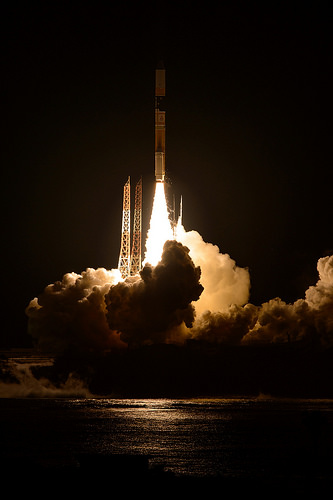
GPM is the lead observatory of a constellation of nine highly advanced Earth orbiting weather research satellites contributed by the US, Japan, Europe and India.
Indeed GPM will be the first satellite to measure light rainfall and snow, in addition to heavy tropical rainfall.
It will collect a treasure trove of data enabling the most comprehensive measurements ever of global precipitation every three hours – and across a wide swath of the planet where virtually all of humanity lives from 65 N to 65 S latitudes.
GPM orbits at an altitude of 253 miles (407 kilometers) above Earth – quite similar to the International Space Station (ISS).
The global precipitation data will be made freely available to climate researchers and weather forecasters worldwide in near real time – something long awaited and not possible until now.
Water and the associated water and energy cycles are the basis of all life on Earth.
Yet scientists lack a clear and comprehensive understanding of key rain and snow fall amounts on most of the globe – which is at the heart of humanity’s existence and future well being on the home planet.
Having an accurate catalog of the water and energy cycles will direct benefit society and impact people’s lives on a daily basis with improved weather forecasts, more advanced warnings of extreme weather conditions, aid farmers, help identify and determine the effects of global climate change.
Researchers will use the GPM measurements to study climate change, freshwater resources, floods and droughts, and hurricane formation and tracking.
“With this launch, we have taken another giant leap in providing the world with an unprecedented picture of our planet’s rain and snow,” said NASA Administrator Charles Bolden, in a NASA statement.
 “GPM will help us better understand our ever-changing climate, improve forecasts of extreme weather events like floods, and assist decision makers around the world to better manage water resources.”
“GPM will help us better understand our ever-changing climate, improve forecasts of extreme weather events like floods, and assist decision makers around the world to better manage water resources.”
“The GPM spacecraft has been under development for a dozen years,” said GPM Project Manager Art Azarbarzin of NASA’s Goddard Space Flight Center in Greenbelt, Md., in a prelaunch interview with Universe Today conducted inside the clean room with GPM before it’s shipment to Japan.

“The GPM satellite was built in house by the dedicated team at NASA’s Goddard Space Flight Center in Maryland,” Azarbarzin told me.
“It’s the largest satellite ever built at Goddard.”
Following the flawless blastoff, the nearly four ton GPM spacecraft separated from the Japanese rocket some 16 minutes later at an altitude of 247 miles (398 kilometers).
10 minutes later both of the spacecrafts life giving solar arrays deployed as planned.
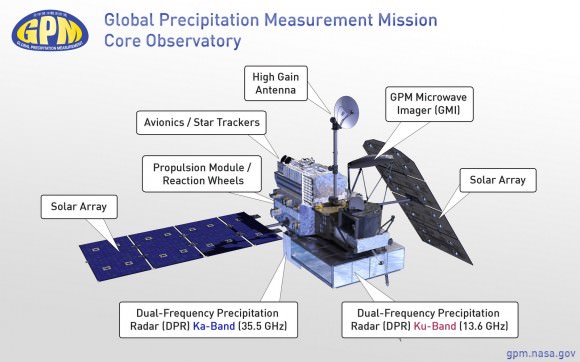
“It is incredibly exciting to see this spacecraft launch,” said Azarbarzin, in a NASA statement. He witnessed the launch in Japan.
“This is the moment that the GPM Team has been working toward since 2006.”
“The GPM Core Observatory is the product of a dedicated team at Goddard, JAXA and others worldwide.”
“Soon, as GPM begins to collect precipitation observations, we’ll see these instruments at work providing real-time information for the scientists about the intensification of storms, rainfall in remote areas and so much more.”
The $933 Million observatory is a joint venture between the US and Japanese space agencies, NASA and the Japan Aerospace Exploration Agency (JAXA).
The 3850 kilogram GPM satellite is equipped with two instruments – an advanced, higher resolution dual -frequency precipitation (DPR) radar instrument (Ku and Ka band) built by JAXA in Japan and the GPM microwave imager (GMI) built by Ball Aerospace in the US.
The GPM observatory will replace the aging NASA/JAXA Tropical Rainfall Measuring Mission (TRMM) satellite launched back in 1997 and also jointly developed by NASA and JAXA.
“GPM is the direct follow-up to the currently orbiting TRMM satellite,” Azarbarzin explained to me.
“TRMM is reaching the end of its usable lifetime. After GPM launches we hope it has some overlap with observations from TRMM.”
GPM is vital to continuing the TRMM measurements. It will help provide improved forecasts and advance warning of extreme super storms like Hurricane Sandy and Super Typhoon Haiyan.
“TRMM was only designed to last three years but is still operating today. We hope GPM has a similar long life,” said Azarbarzin.
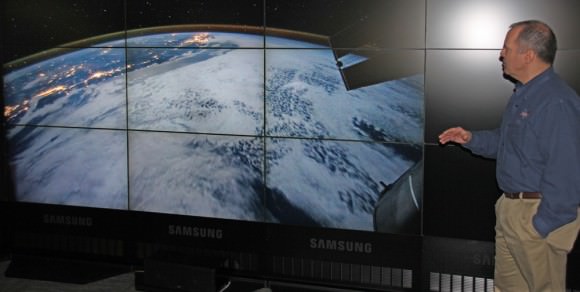
Stay tuned here for Ken’s continuing GPM reports and on-site coverage at NASA Goddard Space Flight Center in Maryland.
And watch for Ken’s continuing planetary and human spaceflight news about Curiosity, Opportunity, Chang’e-3, SpaceX, Orbital Sciences, LADEE, MAVEN, MOM, Mars, Orion and more.
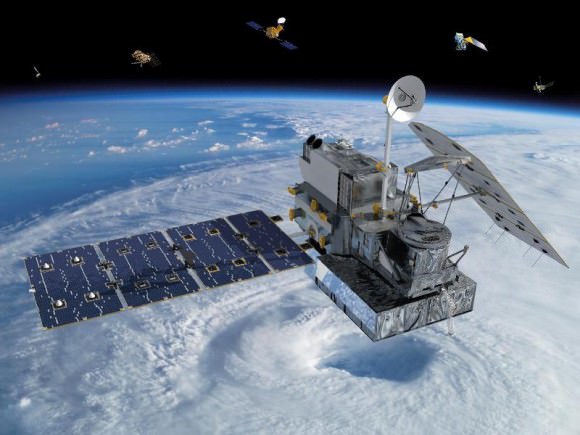
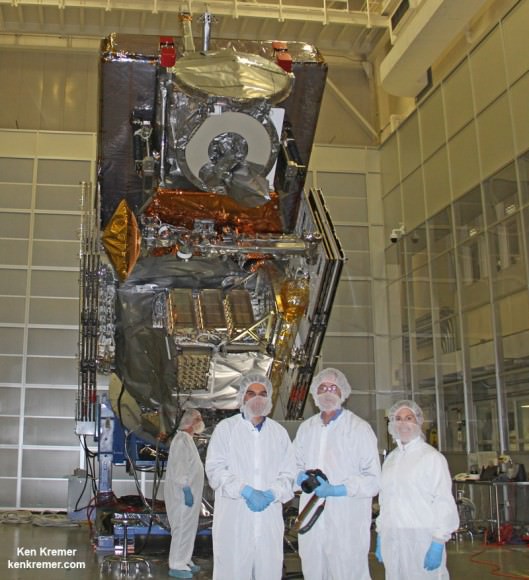
Powerful New Next-Gen US/Japan GPM Satellite to Revolutionize Global Precipitation Observations and Climate Science Research
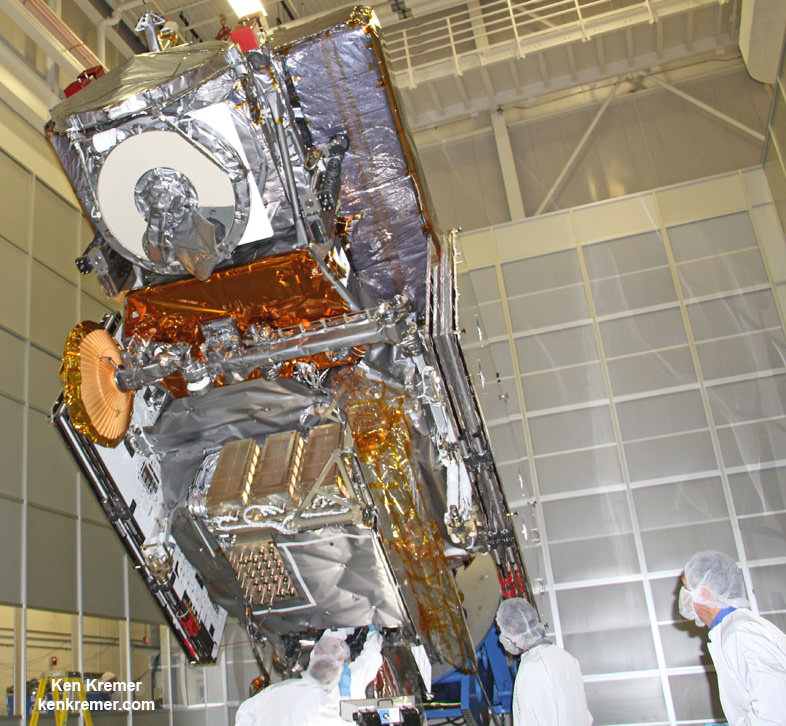
NASA GODDARD SPACE FLIGHT CENTER, MARYLAND – Weather researchers and forecasters worldwide are gushing with excitement in the final days leading to blastoff of the powerful, new Global Precipitation Measurement (GPM) Core Observatory – built by NASA in a joint effort with Japan.
GPM is a next-generation satellite that will provide global, near real time observations of rain and snow from space and thereby open a new revolutionary era in global weather observing and climate science. Therefore it will have a direct impact on society and people’s daily lives worldwide.
The team is counting down to liftoff in less than 5 days, on Feb. 27 at 1:07 PM EST from the Tanegashima Space Center, on Tanegashima Island off southern Japan, atop the highly reliable Mitsubishi Heavy Industries H-IIA rocket.
The GPM launch to low Earth orbit was delayed by both natural and manmade disasters – namely the 2011 Fukushima earthquake in Japan as well as the ridiculous US government shutdown in Oct. 2013. That’s the same foolish shutdown that also delayed NASA’s new MAVEN Mars orbiter and numerous other US space & science projects.
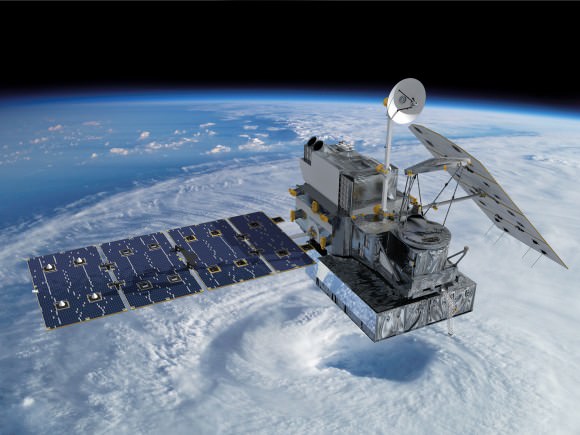
The $933 Million mission is a joint venture between NASA and the Japan Aerospace Exploration Agency (JAXA), Japan’s space agency.
The mission will significantly advance our understanding of Earth’s water and energy cycles and improve forecasting of extreme weather events.
It is equipped with an advanced, higher resolution dual -frequency precipitation (DPR) radar instrument (Ku and Ka band) built by JAXA in Japan and the GPM microwave imager (GMI) built by Ball Aerospace in the US.
“The GPM satellite was built in house at NASA’s Goddard Space Flight Center in Maryland,” Art Azarbarzin, GPM project manager, told Universe Today during my exclusive up-close clean room inspection tour of the huge satellite as final processing was underway.
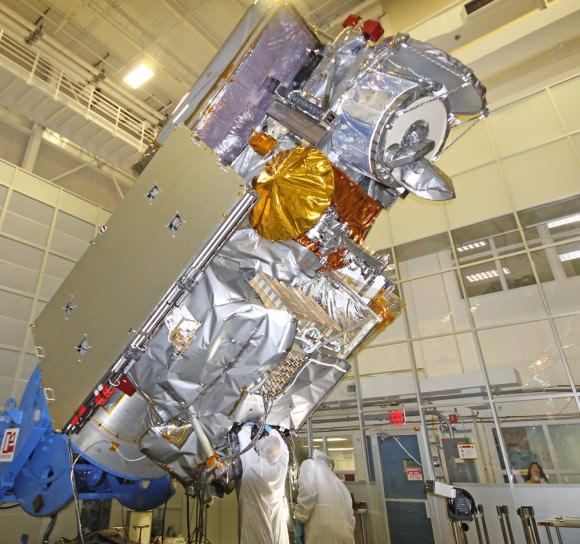
Shortly after my tour of GPM, the 3850 kilogram satellite was carefully packed up for shipment to the Japanese launch site.
“GPM will join a worldwide constellation of current and planned satellites,” Azarbarzin told me during an interview in the Goddard cleanroom with GPM.
 And the imminent launch to augment the existing satellite constellation can’t come soon enough, he noted.
And the imminent launch to augment the existing satellite constellation can’t come soon enough, he noted.
The GPM observatory will replace the aging NASA/JAXA Tropical Rainfall Measuring Mission (TRMM), satellite launched back in 1997.
“GPM is the direct follow-up to the currently orbiting TRMM satellite,” Azarbarzin explained.
“TRMM is reaching the end of its usable lifetime. GPM launches on February 27, 2014 and we hope it has some overlap with observations from TRMM.”
“The Global Precipitation Measurement (GPM) observatory will provide high resolution global measurements of rain and snow every 3 hours,” Dalia Kirschbaum, GPM research scientist, told me during an interview at Goddard.
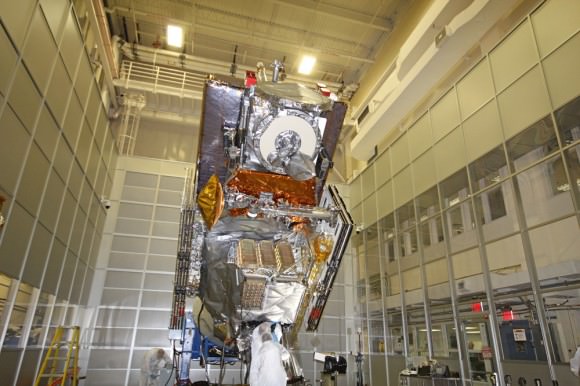
It is vital to continuing the TRMM measurements and will help provide improved forecasts and advance warning of extreme super storms like Hurricane Sandy and Super Typhoon Haiyan, Azarbarzin and Kirschbaum explained.
Researchers will use the GPM measurements to study climate change, freshwater resources, floods and droughts, and hurricane formation and tracking.
“The water-cycle, so familiar to all school-age young scientists, is one of the most interesting, dynamic, and important elements in our studies of the Earth’s weather and climate,” said John Grunsfeld, associate administrator for NASA’s Science Mission Directorate in Washington, in a statement.
“GPM will provide scientists and forecasters critical information to help us understand and cope with future extreme weather events and fresh water resources.”
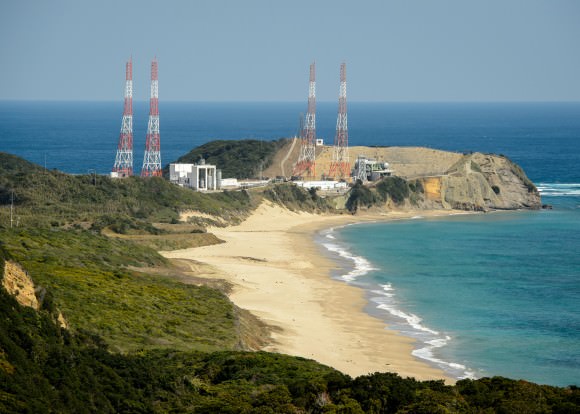
NASA TV will carry the launch live with commentary starting at 12 Noon EST on Feb. 27.
Stay tuned here for Ken’s continuing GPM reports and onsite coverage at NASA Goddard Space Flight Center in Maryland.
And watch for Ken’s continuing planetary and human spaceflight news about Curiosity, Opportunity, Chang’e-3, SpaceX, Orbital Sciences, LADEE, MAVEN, MOM, Mars, Orion and more.

NASA Extends LADEE Dust Explorer for Bonus Lunar Science
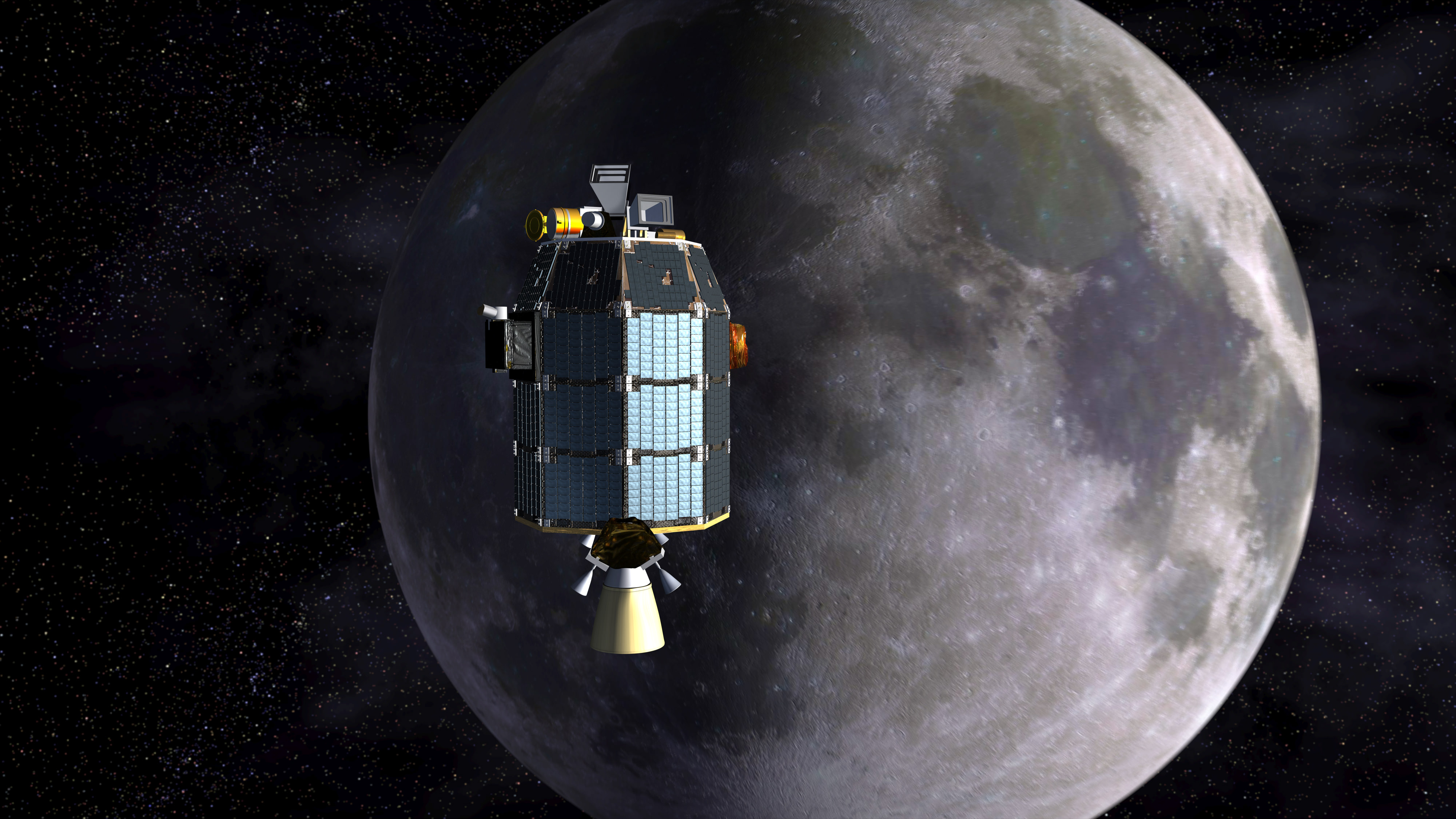
Depiction of NASA’s Lunar Atmosphere and Dust Environment Explorer (LADEE) observatory as it approaches lunar orbit.Credit: NASA Ames/Dana Berry
LADEE will now orbit far lower than ever before – details below![/caption]
LADEE, NASA’s latest lunar orbiter, is getting a new lease on life and will live a little longer to study the mysteries of the body’s tenuous atmosphere, or exosphere, and make surprising new discoveries while hugging Earth’s nearest neighbor even tighter than ever before, the team told Universe Today.
NASA has announced that the Lunar Atmosphere and Dust Environment Explorer (LADEE) mission will be granted a month long extension since the residual rocket fuel is more than anticipated due to the expertise of LADEE’s navigation engineers.
This is great news because it means LADEE’s three research instruments will collect a big bonus of science measurements about the pristine lunar atmosphere and dust during an additional 28 days in an ultra tight low orbit skimming around the Moon.
And the extension news follows closely on the heels of LADEE being photographed in lunar orbit for the first time by a powerful camera aboard NASA’s five year old Lunar Reconnaissance Orbiter (LRO), her orbital NASA sister – detailed here.
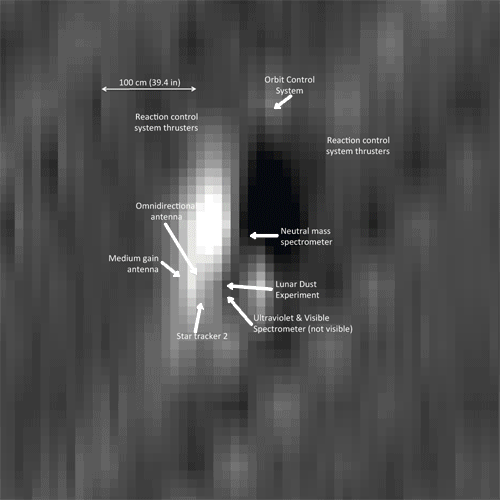
LADEE is currently flying around the moon’s equator at altitudes ranging barely eight to 37 miles (12-60 kilometers) above the surface which crosses over from lunar day to lunar night approximately every two hours.
During the extended mission lasting an additional full lunar cycle, LADEE will fly even lower to within a few miles (km) thereby allowing scientists an exceptional vantage point to unravel the mysteries of the moon’s atmosphere.
Just how low will LADEE fly?
I asked Rick Elphic, LADEE project scientist at NASA Ames Research Center, Moffett Field, Calif.
“We will be taking LADEE from its nominal 20 to 50 kilometer periapsis right down to the treetops — we want to get data from 5 kilometers or even less!” Elphic told me.
“So far we’ve been keeping a healthy margin for spacecraft safety, but after the nominal mission is completed, we will relax those requirements in the interest of new science.”
With the measurements collected so far the science team has already established a baseline of data for the tenuous lunar atmosphere, or exosphere, and dust impacts, says NASA.
Therefore the LADEE team is free to fly the spacecraft much lower than ever before.
And why even go to lower altitudes? I asked Elphic.
Basically because the team hopes to see changes in the particle density and composition.
“The density depends on the species. For instance, argon-40 is heavier than neon-20, and has a lower scale height. That means we should see a big increase in argon compared to neon.”
“And we may see the heavier species for the first time at these really low altitudes.”
“It’s remotely possible we’ll see krypton, for instance.”
“But the real boon will be in the dust measurements.”
“LDEX (The Lunar Dust Experiment) will be measuring dust densities very close to the surface, and we will see if something new shows up. Each time we’ve dropped our orbit down to lower altitudes, we’ve been surprised by new things,” Elphic told Universe Today.
The Neutral Mass Spectrometer (NMS) instrument will measure the identity and abundances of the exospheres constituents, such as argon, neon and krypton.
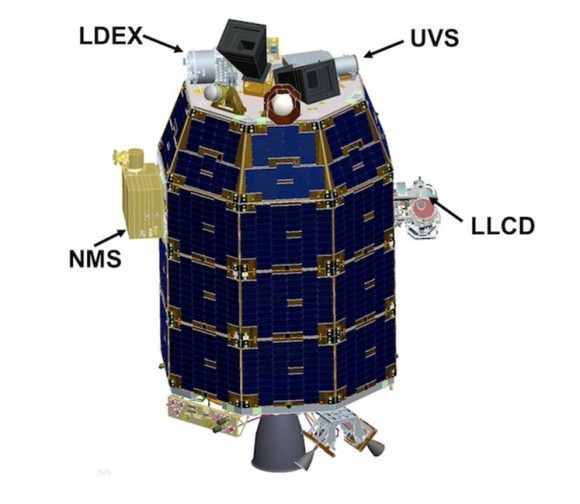
With the extension, LADEE is expected to continue capturing data in orbit until about April 21, 2014, depending on the usage of the declining on board fuel to feed its maneuvering thrusters.
“LADEE is investigating the moons tenuous exosphere, trace outgases like the sodium halo and lofted dust at the terminator,” Jim Green, Planetary Science Division Director at NASA HQ, told me earlier in an exclusive interview.
“The spacecraft has a mass spectrometer to identify the gases, a physical dust detector and an imager to look at scattered light from the dust. These processes also occur at asteroids.”
The Lunar Dust Experiment (LDEX) recorded dust impacts as soon as its cover opened, says NASA and is also seeing occasional bursts of dust impacts caused by meteoroid showers, such as the Geminids.
By studying the raised lunar dust, scientists also hope to solve a 40 year old mystery – Why did the Apollo astronauts and early unmanned landers see a glow of rays and streamers at the moon’s horizon stretching high into the lunar sky.
The science mission duration had initially been planned to last approximately 100 days and finish with a final impact on the Moon on about March 24th.
And the team had told me before launch that an extension was rather unlikely since the spacecraft would be flying in such a very low science orbit of about 50 kilometers altitude above the moon that it will require considerable fuel to maintain.
“LADEE is limited by the amount of onboard fuel required to maintain orbit,” Doug Voss, launch manager, Wallops, told me.
So what accounts for the extension?
Basically it’s because of the expert navigation by NASA’s engineers and the Orbital Sciences Minotaur V rocket and upper stages following the spectacular night time LADEE blastoff from NASA Wallops, VA, on Sept. 6, 2013 and subsequent insertion into lunar orbit.
“The launch vehicle performance and orbit capture burns using LADEE’s onboard engines were extremely accurate, so the spacecraft had significant propellant remaining to enable extra science,” said Butler Hine, LADEE project manager at NASA’s Ames where the mission was designed, built, tested, in a NASA statement.
“This extension represents a tremendous increase in the amount of science data returned from the mission.”
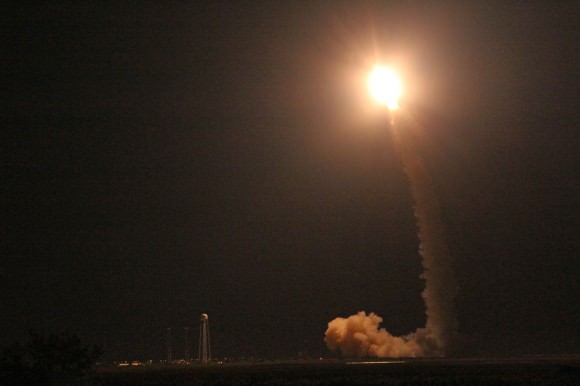
“LADEE launched with 134.5 kilograms of fuel. After the third lunar orbit insertion burn (LOI-3), 80% of our fuel had been consumed,” said Dawn McIntosh, LADEE deputy project manager at NASA Ames Research Center, in an exclusive interview with Universe Today.
“Additional orbit-lowering maneuvers with the orbital control system (OCS) and reaction control system (RCS) of approximately 40 seconds were used to get LADEE into the science orbit.
And LADEE’s orbit capture was accomplished amidst the ridiculous US government shutdown with a skeleton crew.
The spacecraft finally entered its planned two hour science orbit around the moon’s equator on Nov. 20.
So LADEE’s orbital lifetime depends entirely on the remaining quantity of rocket fuel.
“LADEE has about 20 kg of propellant remaining today,” Butler Hine told Universe Today.
The 844 pound (383 kg) robot explorer is the size of a couch and was assembled at NASA’s Ames Research Center, Moffett Field, Calif., and is a cooperative project with NASA Goddard Spaceflight Center in Maryland.
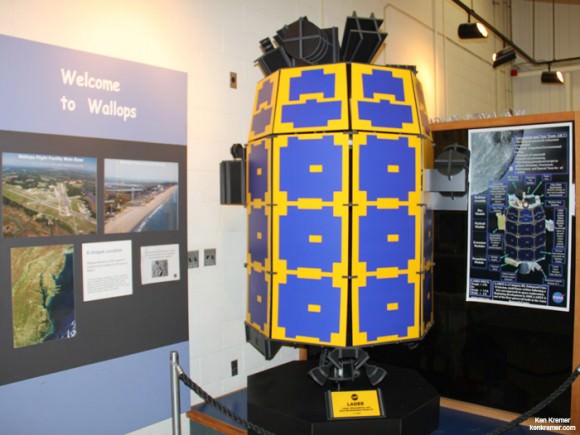
The $280 million probe is built on a revolutionary ‘modular common spacecraft bus’, or body, that could dramatically cut the cost of exploring space and also be utilized on space probes to explore a wide variety of inviting targets in the solar system.
“LADEE is the first in a new class of interplanetary exploration missions,” NASA Ames Center Director Pete Worden told me in an interview. “It will study the pristine moon to study significant questions.”
“This is probably our last best chance to study the pristine Moon before there is a lot of human activity there changing things.”
To date LADEE has traveled over 1 million miles and in excess of 1200 equatorial orbits around the Moon.
LADEE is also searching for any changes caused to the exosphere and dust by the landing of China’s maiden Chang’e-3 lander and Yutu moon rover in December 2013.
Stay tuned here for Ken’s continuing LADEE, Chang’e-3, Orion, Orbital Sciences, SpaceX, commercial space, Mars rover and more news.
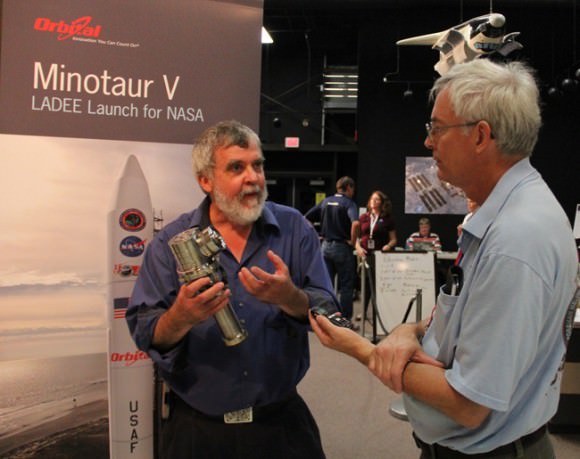
Close Encounters of the Lunar Kind – LRO images LADEE

This dissolve animation compares the LRO image (geometrically corrected) of LADEE captured on Jan 14, 2014 with a computer-generated and labeled image of LADEE . LRO and LADEE are both NASA science spacecraft currently in orbit around the Moon. Credit: NASA/Goddard/Arizona State University
Story updated[/caption]
A pair of NASA spacecraft orbiting Earth’s nearest celestial neighbor just experienced a brief ‘Close Encounter of the Lunar Kind’.
Proof of the rare orbital tryst has now been revealed by NASA in the form of spectacular imagery (see above and below) just released showing NASA’s recently arrived Lunar Atmosphere and Dust Environment Explorer (LADEE) lunar orbiter being photographed by a powerful camera aboard NASA’s five year old Lunar Reconnaissance Orbiter (LRO) – as the two orbiters met for a fleeting moment just two weeks ago.
See above a dissolve animation that compares the LRO image (geometrically corrected) of LADEE captured on Jan. 14, 2014 with a computer-generated and labeled LADEE image.
All this was only made possible by a lot of very precise orbital calculations and a spacecraft ballet of sorts that had to be nearly perfectly choreographed and timed – and spot on to accomplish.
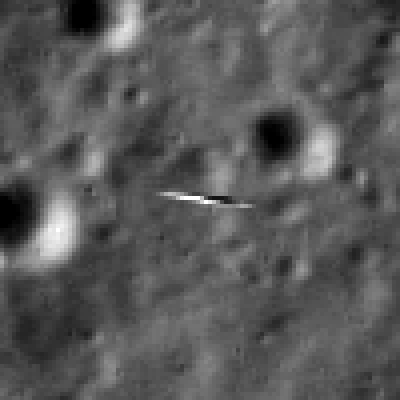
Both sister orbiters were speeding along at over 3600 MPH (1,600 meters per second) while traveling perpendicularly to one another!
So the glimpse was short but sweet.
LADEE flies in an equatorial orbit (east-to-west) while LRO travels in a polar orbit (south-to-north). LADEE achieved lunar orbit on Oct. 6, 2013 amidst the federal government shutdown.
Thus their orbits align only infrequently.
The LRO orbiter did a pirouette to precisely point its high resolution narrow angle camera (NAC) while hurtling along in lunar orbit, barely 5.6 miles (9 km) above LADEE.
And it was all over in less than the wink of an eye!
LADEE entered LRO’s Narrow Angle Camera (NAC) field of view for 1.35 milliseconds and a smeared image of LADEE was snapped. LADEE appears in four lines of the LROC image, and is distorted right-to-left.
Both spacecraft are tiny – barely two meters in length.
“Since LROC is a pushbroom imager, it builds up an image one line at a time, thus catching a target as small and fast as LADEE is tricky!” wrote Mark Robinson, LROC principal investigator of Arizona State University.
So the fabulous picture was only possible as a result of close collaboration and extraordinary teamwork between NASA’s LADEE, LRO and LROC camera mission operations teams.
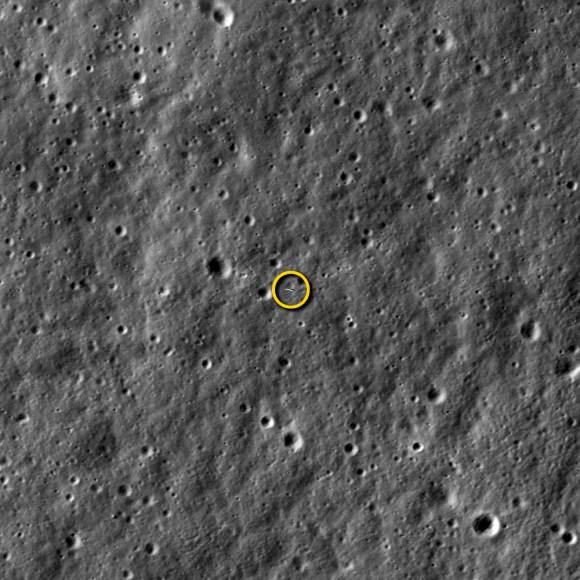
LADEE passed directly beneath the LRO orbit plane a few seconds before LRO crossed the LADEE orbit plane, meaning a straight down LROC image would have just missed LADEE, said NASA.
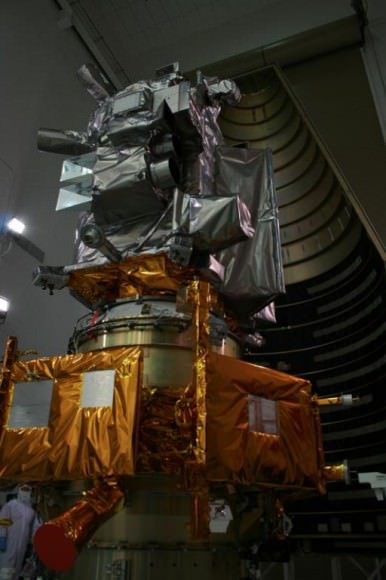
Therefore, LRO was rolled 34 degrees to the west so the LROC detector (one line) would be precisely oriented to catch LADEE as it passed beneath.
“Despite the blur it is possible to find details of the spacecraft. You can see the engine nozzle, bright solar panel, and perhaps a star tracker camera (especially if you have a correctly oriented schematic diagram of LADEE for comparison),” wrote Robinson in a description.
See the LADEE schematic in the lead image herein.
LADEE was launched Sept. 6, 2013 from NASA Wallops in Virginia on a science mission to investigate the composition and properties of the Moon’s pristine and extremely tenuous atmosphere, or exosphere, and untangle the mysteries of its lofted lunar dust.
Since LADEE is now more than halfway through its roughly 100 day long mission, timing was of the essence before the craft takes a death dive into the moon’s surface.
You can see a full scale model of LADEE at the NASA Wallops visitor center, which offers free admission.

LRO launched Sept. 18, 2009 from Cape Canaveral, Florida to conduct comprehensive investigations of the Moon with seven science instruments and search for potential landing sites for a return by human explorers. It has collected astounding views of the lunar surface, including the manned Apollo landing sites as well as a treasure trove of lunar data.
In addition to NASA’s pair of lunar orbiters, China recently soft landed two probes on the Moon.
So be sure to read my new story detailing how LRO took some stupendous Christmas time 2013 images of China’s maiden lunar lander and rover; Chang’e-3 and Yutu from high above- here.
Stay tuned here for Ken’s continuing LADEE, Chang’e-3, Orion, Orbital Sciences, SpaceX, commercial space, Mars rover and more news.
